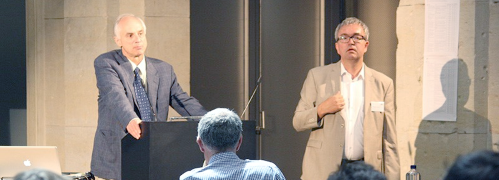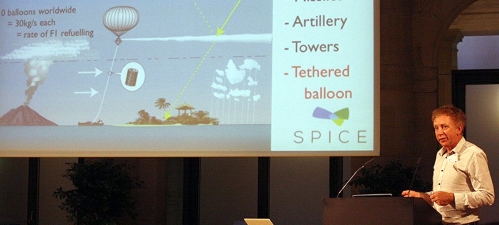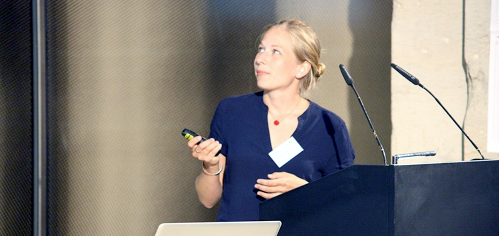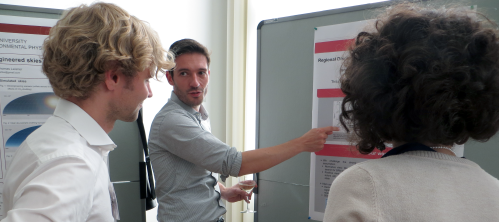Day 1 - Could we?
(comments: 0)

Day 1: Tuesday July 7, 2015 - Berlin-Brandenburg Academy of Sciences and Humanities
Although many hold high hopes for the next international climate conference in Paris this winter (COP 15), evidence suggests that environmental, technological, economic and social inertia will prevent the world's major polluters from reducing carbon dioxide emissions fast enough to prevent dangerous climate change. This has led to the increased consideration of a range of Climate Engineering (CE) technologies, which can be grouped into two main categories; Carbon Dioxide Removal (CDR) methods, which aim to reduce the levels of carbon dioxide (CO2) in the atmosphere, allowing outgoing long-wave heat radiation to escape more easily, and Solar Radiation Management (SRM) methods, which aim to reduce the net incoming short-wave solar radiation and thus warmth reaching the Earth. While SRM technologies may be able to reduce the risks associated with rapid climate change, they do not represent an alternative to carbon management. As Klaus Lackner outlined in today's introductory lecture, the inherent inertia of the global carbon system means that stabilizing emissions to meet the 2 degree target outlined by the IPCC requires not only the reduction of global net emissions to zero, but also implies the need for negative emissions. Therefore, as the symposium's opening presentation emphasized, a deeper understanding of the feasibility of both CDR and SRM technologies is needed as soon as possible.
This week's symposium aims to deal with a wide spectrum of Climate Engineering related questions, but today's session focused on what is arguably one of the most fundamental of them all: Could we do it? [1] Entitled "Scientific Feasibility of Climate Engineering Ideas," the first session of the week included talks by seven natural scientists and engineers who addressed the "Could we?" question from different perspectives.
We were updated on a plurality of practical CE puzzles being addressed around the world. First, Jon Egill Kristjansson told us about the fine line a potential cloud seeder would have to walk by seeding small, homogenous ice nuclei in cirrus clouds, which then cool the planet by letting more long-wave radiation out, but making sure not to "over-seed", as injecting too many nuclei would mean reduced solar reflection and subsequently more warming. We heard that although initial modeling on cirrus cloud "thinning" in this manner indicates that the method is scientifically feasible, as one member of the audience pointed out, very little is known about its technical feasibility. The creation of small, homogenous ice nuclei in cirrus clouds could cool the planet, but a multitude of questions remain regarding how, where and under what conditions such particles can be successfully created.

The second speaker, Rolf Müller, filled us in on how little is currently known about the way in which injecting sulphates into the stratosphere may affect the ozone layer. He went on to emphasize that future models need to look at the sensitivity of chlorine particles and moisture when assessing the effects of sulphur-based Solar Radiation Management (SRM) techniques. In a related talk on the technical complications associated with getting sulphur particles up into the stratosphere some 20 km above our heads, Hugh Hunt explained that delivering 10 million tonnes of particles a year using aircraft would roughly double today's global aviation traffic, requiring approximately 30,000 flights per day. A potentially much less expensive (and considerably quieter) alternative involving only 10 tethered balloons with hoses attached, delivering a steady flow of particles at a rate of 300 kg per second would seem a much simpler option. But then we heard about the troubles the wind poses for this type of delivery system, the fact that a tether strong enough hold an enormous balloon 20 km above the Earth's surface for an indefinite period does not yet exist, and the fear that SO2 pumped up such a long hose would need to be under such high pressure that it would solidify rather than "flow steadily" as originally envisioned. Other open questions raised in the subsequent discussion included the suitable framing of future tests; potential incompatibility between the scientifically optimal location for the launch of such balloons and the technical practicalities involved (weather conditions, population, flight paths etc); and the concern that successful initial testing may lead to the method becoming increasingly "politically tempting."

Coming down from the heavens, Lena Boysen followed with her talk focused on the potentials of terrestrial CO2 sequestration using biomass plantations. Although these sequestration alternatives are often considered attractive and "green," today we heard that they are likely to have a multitude of side-effects on the water cycle, food production, biodiversity and the planet's albedo. Additionally, modeling results suggest that even dramatic shifts in land use would not remove enough carbon from the atmosphere to reduce warming significantly: Even simulated so-called 100% replacement scenarios in which all agricultural land was replaced with biomass plantations did not result in a dramatic reduction in warming within the model parameters. Greening the planet may be desirable for a variety of reasons, but this presentation suggested afforestation alone will not be enough to reduce warming significantly.
The final two presentations on this warm Tuesday in Berlin [2] focused on olivine accelerated weathering, with Peter Köhler looking at ocean fertilization and Thorben Amann discussing the effects of element release as a consequence of land-based weathering. A simulated CO2 removal experiment on the role of iron during olivine dissolution in the open ocean showed that the size of the olivine grains played a huge role in the effective dissolution: Too large and they sink, too light and they remain in the surface layers. Questions were raised by members of the audience about how the grains of the optimal size would be sourced - would naturally ground small particles be transported from beaches, or would larger particles be ground, and how would the energy use of the two options compare? The land-based use of ground rock particles poses different problems - during the final presentation of the day, Thorben Amann indicated that although the particles can release fertilizing nutrients which could be beneficial to agriculture, the rock types with most enhanced weathering carbon capture potential also contain trace heavy metals. The use of this method would therefore boil down to a trade-off between fertilising potential, trace metal release level and CO2 capture potential.
After a long, interesting day of talks, we found ourselves trickling out of the conference hall with even more questions to ponder. Today's speakers showed us that before an answer to the deceptively simple query posed at the start of this post can be found, a multitude of much more complex questions remain to be answered.

[1] For those of you wondering, rest assured, the related questions of if we should do it and who "we" are will be given equal attention in later sessions.
[2] Despite the sweltering heat, surprisingly, only one joke was told about the weather.

Add a comment